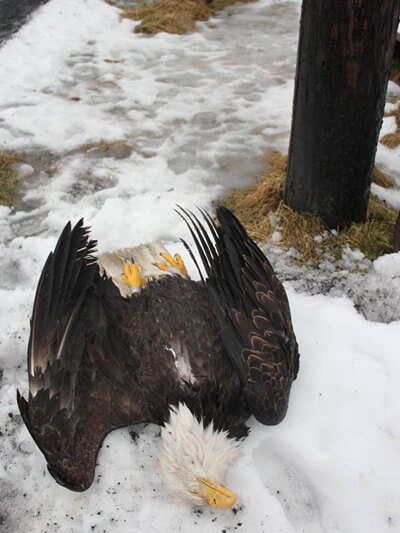Death of Second Oldest Alaskan Bald Eagle Highlights Threats to Birds From Power Lines
For Immediate Release Contact:
, 202-234-7181 ext. 210
 |
Bald Eagle death from a power line on Kodiak Island, Alaska. Photo: U.S. Fish and Wildlife Service (High resolution versions available upon request) |
(Washington, D.C.,
“The threat to birds from power lines comes in two forms: electrocution when a large bird comes into contact with two lines or a line and a pole simultaneously, and collisions with the hard-to-see lines. We are very concerned that with the rapid expansion in wind power, numbers of both causes of mortality will rise. To meet the 2030 goal, the nation will need to produce about 12 times more wind energy than in 2009, which will dramatically increase the threat to birds such as the Bald Eagle unless appropriate mitigation takes place,” said George Fenwick, ABC’s President.
A band retrieved from the dead eagle confirmed that it was the second oldest on record in Alaska. The oldest found in the Unites States was a 32-year-old Bald Eagle from Maine. A wildlife biologist from the U.S. Fish and Wildlife Service said that, based on records she has seen, the bird may have been one of the ten oldest [Bald Eagles] ever recorded. The bird was captured in 1989 following the Exxon Valdez oil spill that happened earlier in the year.
A band retrieved from the dead eagle confirmed that it was the second oldest on record in Alaska. The oldest found in the Unites States was a 32-year-old Bald Eagle from Maine. A wildlife biologist from the U.S. Fish and Wildlife Service said that, based on records she has seen, the bird may have been one of the ten oldest [Bald Eagles]ever recorded. The bird was captured in 1989 following the Exxon Valdez oil spill that happened earlier in the year.
“That eagle survived one of Mother Nature’s harshest climates for 25 years, only to find death on a man-made utility pole,” he added.
 |  |
Bald Eagle death from a power line on Kodiak Island, Alaska. Photo: U.S. Fish and Wildlife Service (High resolution versions available upon request) | |
“Wind farms require the installation of large numbers of utility poles and power lines. Unless buried or properly insulated, those power lines can electrocute large birds such as Bald and Golden Eagles that perch on poles and lines while hunting,” he said.
“Wind farms are typically located in more remote areas that also require significant build-out of massive high-tension power lines to connect them to the grid. Unless properly marked, these lines can also result in bird deaths through collisions, a particular concern for birds such as the endangered Whooping Crane,” he said.
American Bird Conservancy conserves native birds and their habitats throughout the Americas by safeguarding the rarest species, protecting and restoring habitats, and reducing threats while building capacity of the bird conservation movement. For more information, visit, www.abcbirds.org


















































